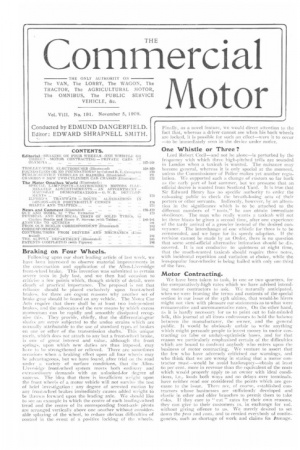Braking on Four Wheels.
Page 1

If you've noticed an error in this article please click here to report it so we can fix it.
Following upon our short leading article of lost week, we have been interested to observe material improvements in the construction and application of the Allen-Liversidge front-wheel brake. This invention was submitted to certain severe tests in July Iasi, and we then had occasion to criticise a few points which, though strictly of detail, were clearly of practical importance. The proposal is not that reliance should be placed exclusively upon front-wheel brakes, for there are cogent reasons why another set of brake gear should be found on any vehicle. The Motor Car Acts require that there shall he at least two independent brakes, and the advocates of the new means by which excess momentum can be rapidly and smoothly dissipated recognise this. They provide, chiefly, that the differential-gear shafts are never subjected to the undue strains which are normally attributable to the use of standard types of brakes on one or other of the transmission shafts. This unique merit, which does not attach to any but a front-wheel brake, is One of great interest and value, although the front springs, upon which new duties are thus imposed, may have to he strengthened or relieved. There are sometimes occasions when a braking effect upon all four wheels may be advantageous, but we have found, after trial on the road under a variety of surface conditions, that the AllenLiyersidge front-wheel system meets both ordinary and extraordinary demands with an unlooked-for degree of success. The idea that there is insufficient weight upon the front wheels of a motor vehicle will not survive the test of brief investigation : any degree of arrested motion by any front-wheel brakes immediately causes added weight to be thrown forward upon the leading axle. We should like to see an example in which the centre of each leading-wheel tread and the centre of its corresponding front-axle pivots are arranged vertically above one another without considerable splaying of the wheel, to reduce obvious difficulties of control in the event of a positive locking of the wheels.
Finally, as a novel feature, we would direct attention to the fact that, whereas a driver cannot see when his hack wheels are locked, ii is possible for such an effect—were it to occur —to be im:nedialely seen in the device under notice.




















